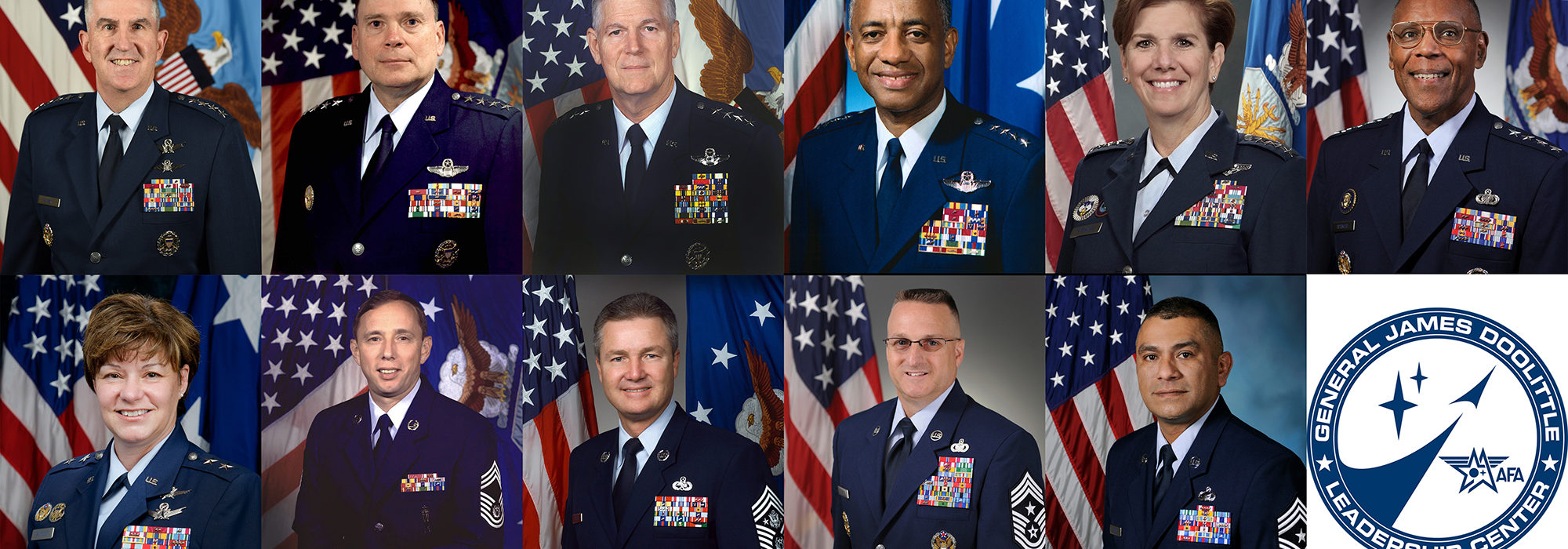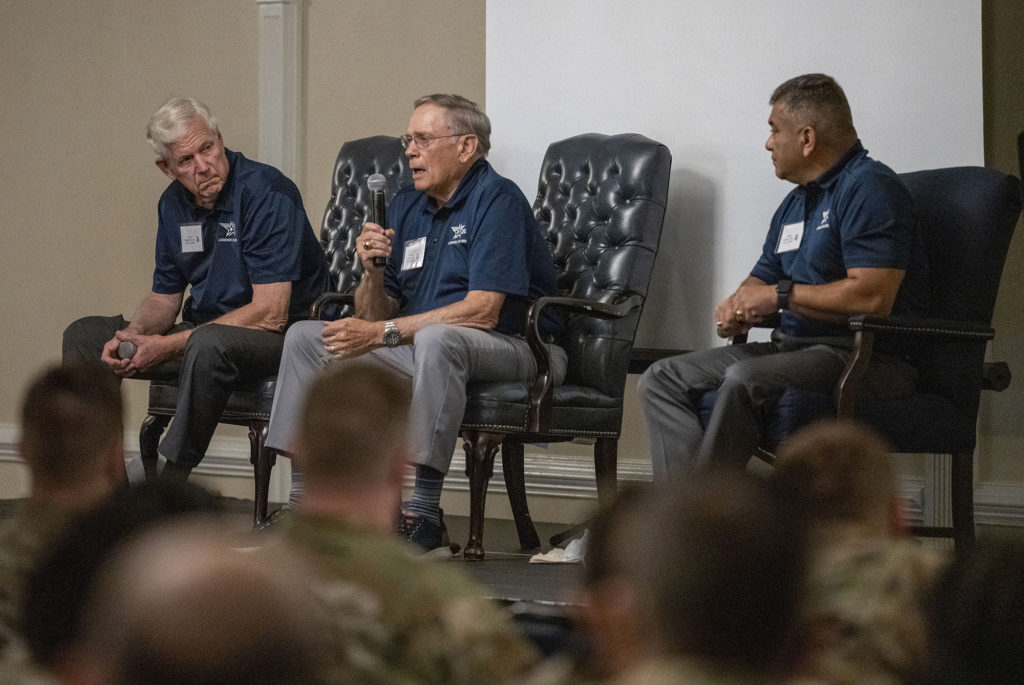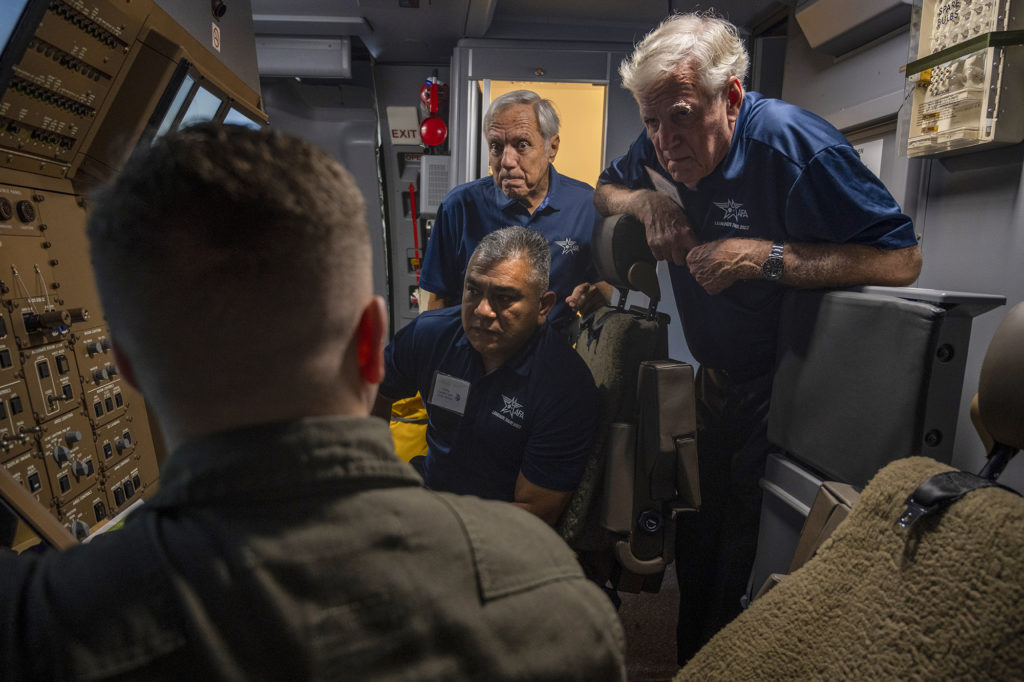To celebrate the Air Force’s 75th anniversary, the Air & Space Forces Association set out to connect 11 “living legends” from Air Force history with Airmen and Guardians in the force today.
The Legends—six retired four-star generals, one retired two-star general, two former Chief Master Sergeants of the Air Force, and two retired chief master sergeants—visited eight Air Force and Space Force bases between July and August, crisscrossing the country to share their stories and experiences with some 3,500 Airmen and Guardians. Their visits opened an intergenerational dialogue between the legends of yesterday and tomorrow.
The genesis of the 75th Anniversary Legends Tour was a conversation between two retired generals: Gen. John P. Jumper (the Air Force’s 17th Chief of Staff) and AFA President Lt. Gen. Bruce “Orville” Wright. They wanted to create a way to connect Active-duty Airmen and Guardians with the wisdom and knowledge of retired senior leaders.
The Legends Tour was organized by the Gen. Jimmy Doolittle Leadership Center (DLC) and its director, Patrick Donley, a retired Air Force colonel and former National War College instructor.
“Just as every superhero has an origin story, the Legends on this stage and those visiting the units are a part of your origin story,” Donley told the audience at Seymour Johnson Air Force Base, N.C., in August. “They are part of your family tree, and they are some of the giants on whose shoulders you stand.”
Seymour Johnson, the fourth stop on the Legends Tour, hosted Jumper; former Chairman of the Joint Chiefs of Staff Gen. Richard B. Myers; former Air Force Vice Chief of Staff Gen. Larry Spencer; Chief Master Sergeant of the Air Force #14 Gerald Murray; and retired Chief Master Sgt. Gerardo Tapia.
The group participated in panel discussions and unit visits, with stops at the 4th Medical Group, the 336th Rocket MX Hangar, and the 916th Air Refueling Wing, where the Legends toured the new KC-46 Pegasus tanker.
“I could not be more proud to be here standing in front of Airmen again,” Jumper said. “They’re the same quality, motivated the same way, and took the same oath that I did many, many decades ago.”
The panels came to life as Airmen took the microphone to pose questions. No subject was off limits, and the Legends shared stories of their greatest personal failures; coping with policy changes; being “voluntold” to take on undesired duties; dealing with political divisiveness; encouraging service; and everything in between.
The questions and responses were unscripted and uncoached. Attending Airmen were encouraged to ask tough questions.
When one Airman asked how the Legends overcame the darkest periods in their lives, Spencer spoke out about military suicide rates and the necessity for anyone to seek help when one needs it.
“There is no stigma,” he said. “You need to get the help that you need. So please, find whatever that is for you.”
Other conversations got personal: Murray opened up to a group of junior Airmen about the personal demons he fought to save his marriage early in his career. Tapia acknowledged he would have been discharged for bad behavior had it not been for the trust of one particular boss who saw something in him worth cultivating. Spencer told his origin story about how, as an E-3, a chief master sergeant demonstrated to him the importance of holding yourself to worthwhile standards.
“When I was 18 years old, I had an afro like you could not believe,” Spencer said. Despite being in the Air Force, he refused to get it cut. Every day when he went to work at Whiteman Air Force Base, Mo., he would hide his hair under his cap in an act of defiance—until the day a chief master sergeant caught him, drove him to a barbershop in his pickup truck, and got him a military cut.
It wasn’t punishment, Spencer said, but an act of leadership. That chief told Spencer it was time to take himself (and his service) seriously, then encouraged him to enroll in the college classes he’d been avoiding. A few years later, that Chief was on hand when Spencer graduated.

“That chief master sergeant talked to me in a way that no one ever talked to me before,” he said. “He wasn’t chewing me out. He cared about me—turned my life around.”
The common thread woven through Spencer’s story and the other Legends’ stories was leadership, and that leaders don’t have to be those at the highest ranks or with the most gray hairs. Leadership involves action and communication.
Indeed, the Legends found the discussions with Airmen were not a one-way street in which wisdom flowed from them to others. On the contrary, they found inspiration in the Active-duty Airmen of today, who they said are shaping their own legacy.
“You are smarter, and you are better prepared to do that than any generation that ever existed,” Jumper said. “And it’s going to be your legacy, your pride that you’re able to accept that … develop that … deploy that and use that. That’s going to be your legacy.”
The Legends repeatedly emphasized how responsibility for making positive change rests on the shoulders of every Airman. That’s true whether they’re sharing a new or better way to do something or changing culture and policy.
“Learn how to go stand on somebody’s desk,” said Spencer. “If you have a good idea, it’s going to break through. So don’t give up—please.”
The 75th Anniversary Legends Tour weaves past and present together, with the aim of reinforcing the future. But reinforcement worked in the other direction, as well. Speaking for all of the Legends, Spencer told Airmen at Seymour Johnson, “Now I get to go home knowing my Air Force is in good hands.”
The value of the tour was not lost on the Airmen, who were overheard to make remarks like, “This was exactly what we needed to hear,” according to Donley.
Donley said AFA and the Doolittle Leadership Center hope to lead additional Legends Tours in the future and are seeking sponsors to help underwrite the cost and continue providing tomorrow’s Legends with the encouragement and support they need today.
“In every session there were powerful moments,” Donley said. “[The Legends] spoke to the Airmen with surprising candor and transparency. Having listened to all of their engagements and been a repeat beneficiary of the wisdom that they’re sharing, I’m confident that this tour has been immeasurably valuable. And from this start, I’m sincerely hoping there will be more opportunities for similar engagements in the future.”
Legends of Air & Space
Eleven Air Force Legends joined one or more legs of the Air & Space Forces Association’s inaugural Legends Tour to visit some 3,500 Airmen and Guardians at eight bases in a series of visits over four weeks. The Legends, all General Officers and Chiefs, varied by location.
Nellis Air Force Base, Nev.
Gen. John Jumper, 17th Air Force Chief of Staff (active 1966-2005)
Gen. Lori Robinson, Commander of USNORTHCOM and NORAD (active 1981-2018)
Gen. Lloyd Newton, Commander of Air Education and Training Command (active 1966-2000)
CMSAF #14 Gerald Murray (active 1977-2006)
Chief Master Sgt. Harold Hutchison, Command Senior Enlisted Leader of NORAD/NORTHCOM (active 1985-2018)
Creech Air Force Base, Nev.
Gen. John Jumper, 17th Air Force Chief of Staff (active 1966-2005)
Gen. Lori Robinson, Commander of USNORTHCOM and NORAD (active 1981-2018)
Gen. Lloyd Newton, Commander of Air Education and Training Command (active 1966-2000)
Chief Master Sgt. Harold Hutchison, Command Senior Enlisted Leader of NORAD/NORTHCOM (active 1985-2018)
Joint Base Lewis-McChord, Wash.
Gen. Richard Myers, 15th Chairman of the Joint Chiefs of Staff (active 1965-2005)
Gen. John Jumper, 17th Air Force Chief of Staff (active 1966-2005)
Gen. Lloyd Newton, Commander of Air Education and Training Command (active 1966-2000)
CMSAF #13 Jim Finch (active 1972-2002)
CMSAF #14 Gerald Murray (active 1977-2006)
Seymour Johnson Air Force Base, N.C.
Gen. Richard Myers, 15th Chairman of the Joint Chiefs of Staff (active 1965-2005)
Gen. John Jumper, 17th Air Force Chief of Staff (active 1966-2005)
Gen. Larry Spencer, Vice Chief of Staff of the Air Force (active 1971-2015)
CMSAF #14 Gerald Murray (active 1977-2006)
Chief Master Sgt. Gerardo Tapia, Command Chief Master Sgt. Air Education and Training Command (active 1985-2016)
Buckley Space Force Base, Colo.
Gen. Richard Myers, 15th Chairman of the Joint Chief of Staff (active 1965-2005)
Gen. John Hyten, 11th Vice Chairman of the Joint Chiefs of Staff (active 1981-2021)
Gen. John Jumper, 17th Air Force Chief of Staff (active 1966-2005)
Maj. General Suzanne Vautrinot, Commander, 24th Air Force (active 1982-2013)
CMSAF #14 Gerald Murray (active 1977-2006)
Chief Master Sgt. Gerardo Tapia, Command Chief Master Sgt. Air Education and Training Command (active 1985-2016)
U.S. Air Force Academy, Colo.
Gen. Richard Myers, 15th Chairman of the Joint Chiefs of Staff (active 1965-2005)
Gen. John Hyten, 11th Vice Chairman of the Joint Chiefs of Staff (active 1981-2021)
Gen. John Jumper, 17th Air Force Chief of Staff (active 1966-2005)
Maj. General Suzanne Vautrinot, Commander, 24th Air Force (active 1982-2013)
CMSAF #14 Gerald Murray (active 1977-2006)
Chief Master Sgt. Gerardo Tapia, Command Chief Master Sgt. Air Education and Training Command (active 1985-2016)
Peterson Space Force Base, Colo.
Gen. Richard Myers, 15th Chairman of the Joint Chiefs of Staff (active 1965-2005)
Gen. John Hyten, 11th Vice Chairman of the Joint Chiefs of Staff (active 1981-2021)
Gen. John Jumper, 17th Air Force Chief of Staff (active 1966-2005)
Maj. General Suzanne Vautrinot, Commander, 24th Air Force (active 1982-2013)
CMSAF #14 Gerald Murray (active 1977-2006)
Chief Master Sgt. Gerardo Tapia, Command Chief Master Sgt. Air Education and Training Command (active 1985-2016)
Schriever Space Force Base, Colo.
Gen. Richard Myers, 15th Chairman of the Joint Chiefs of Staff (active 1965-2005)
Gen. John Hyten, 11th Vice Chairman of the Joint Chiefs of Staff (active 1981-2021)
Gen. John Jumper, 17th Air Force Chief of Staff (active 1966-2005)
Maj. General Suzanne Vautrinot, Commander, 24th Air Force (active 1982-2013)
CMSAF #14 Gerald Murray (active 1977-2006)
Chief Master Sgt. Gerardo Tapia, Command Chief Master Sgt. Air Education and Training Command (active 1985-2016)


